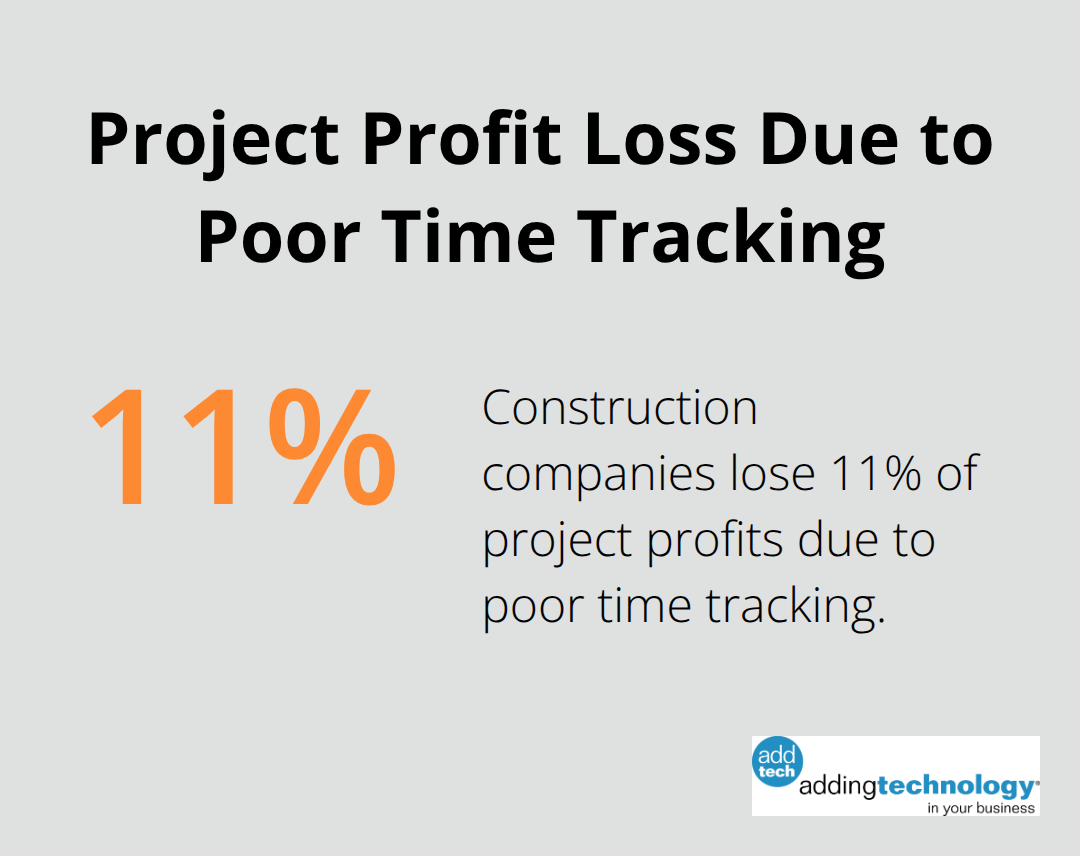
Construction companies lose an average of 11% of their project profits due to poor time tracking and inaccurate labor cost allocation. A job costing time clock system solves this problem by automatically capturing work hours and linking them directly to specific projects.
We at adding technology have seen businesses reduce their labor cost errors by up to 40% after implementing proper time tracking systems. This guide shows you exactly how to set up and optimize your job costing process.

Your time clock software must support hierarchical job codes with at least three levels of detail. Construction projects require you to track by job site, specific tasks like framing or electrical work, and cost centers such as labor types or equipment usage.
Software without multi-level codes forces you into oversimplified tracking that misses critical project costs. Look for systems that handle unlimited job codes and allow real-time switches between projects. GPS tracking becomes essential for field crews, as manual location verification wastes significant time weekly per employee.
Mobile compatibility with offline functionality prevents lost time entries when cellular coverage drops at remote job sites. Field workers need systems that capture data even without internet connection and sync automatically once connectivity returns.
Start with your chart of accounts and create job codes that mirror your existing financial structure. Use numeric prefixes for job sites, alphabetic codes for trade types, and sequential numbers for specific tasks.
A typical residential project needs 15-25 distinct job codes, while commercial projects require 40-60 codes minimum. Set up approval workflows that require supervisor verification for any time entries that exceed 10 hours daily or 50 hours weekly (these often indicate errors).
Configure automatic overtime calculations and shift differentials directly in the system rather than through manual payroll adjustments later. This approach eliminates calculation errors and saves administrative time during payroll processing.
Train supervisors to review daily reports and correct miscoded time within 24 hours. Corrections become exponentially more difficult after payroll processing begins, often requiring manual journal entries that increase error risk.
Establish clear protocols for project switches during the workday. Workers must clock out of one job code before starting another, even for brief interruptions like material pickup or equipment moves.
Create simple reference cards that list common job codes for each project type. Workers spend less time searching through lengthy code lists when they have quick visual references available on-site.
With your time clock system properly configured and your team trained on procedures, you can now focus on connecting this time data to your accounting software for seamless job cost allocation.
Your time clock system must feed data directly into your accounting software without manual data entry. QuickBooks, Sage, and Xero handle automated imports through API connections that update hourly. Manual data transfer creates time gaps and increases the risk of human error and delays payroll processing by an average of 4.2 hours weekly.
Configure your integration to map employee hours directly to the correct general ledger accounts and project codes. Set up validation rules that flag unusual entries like 12-hour days or weekend work that exceeds normal parameters. These automated checks catch time entry errors before they reach your financial statements.
Your system must capture more than basic hourly wages to generate accurate job costs. Include payroll taxes, worker compensation insurance, and benefits that typically add 35-45% to base wages. A carpenter who earns 28 dollars per hour actually costs your company between 37.80 and 40.60 dollars when you factor in all associated expenses.

Track indirect labor separately from direct project work. Administrative time, equipment maintenance, and travel between job sites represent hidden costs that average 18% of total labor expenses. Companies that fail to allocate these costs properly underbid projects by an average of 12% and wonder why profitable jobs on paper generate losses in reality.
Review labor allocation reports every morning to catch miscoded time before it compounds into larger problems. Workers who forget to switch job codes waste an average of 2.3 hours of misallocated time weekly per employee. Daily checks reduce this waste to under 20 minutes weekly and maintain accurate project cost visibility throughout the job lifecycle.
Set up automated alerts when labor costs exceed 85% of budgeted amounts for any project phase. These early warnings allow you to adjust resource allocation or renegotiate project scope before cost overruns become unrecoverable losses.
With accurate time data flowing into your accounting system and proper cost allocation in place, you need specific practices to maintain data accuracy and prevent the common errors that undermine job cost reliability.
Construction companies that require workers to enter time daily report 23% fewer payroll corrections compared to weekly time entry systems. Workers forget project details and approximate hours when they wait until Friday to log their entire week. Memory gaps cost the average construction company 3.2 hours of misallocated labor weekly per employee.
Set up your system to lock previous days after 8 AM the following morning. This forces immediate time entry while project details remain fresh. Configure automatic reminders at 6 PM for workers who haven’t logged their hours. Companies that use these strict deadlines reduce time entry errors and eliminate the administrative burden of chasing missing timesheets.
Supervisors must review and approve all time entries within 48 hours of submission. Focus audits on entries that exceed 10 hours daily, weekend work, or unusual job code combinations. These patterns indicate potential time tracking errors according to recent payroll processing studies.
Create exception reports that flag workers who switch between more than four job codes daily. Excessive switching often signals confusion about proper coding procedures or indicates workers split time incorrectly. Train supervisors to question entries where travel time exceeds 15% of total daily hours, as this typically represents miscoded administrative time that should be allocated to indirect costs.
Field workers who use mobile time tracking with GPS verification report 89% more accurate location data than manual systems. Geo-fencing technology prevents workers from clocking in until they arrive within 200 feet of designated job sites. This eliminates early clock-ins during commute time that artificially inflate project labor costs.

Choose mobile apps that function offline and sync automatically when connectivity returns. Remote job sites often have poor cellular coverage, and workers lose time weekly when they try to log time on systems that require constant internet connection. Offline functionality captures all time data and prevents the gaps that force expensive manual reconstructions during payroll processing.
A job costing time clock system transforms construction profitability through systematic time tracking and accurate cost allocation. Companies that follow these steps reduce labor cost errors by 40% and eliminate the 11% profit loss from poor time tracking. Your success depends on software with multi-level job codes, proper integration with accounting systems, and daily time entry requirements.
GPS-enabled mobile tracking and supervisor audits maintain data accuracy while automated workflows prevent costly manual errors. Construction businesses that master job costing time clock systems gain competitive advantages through precise project bidding and real-time cost visibility. These systems pay for themselves within three months through improved accuracy and reduced administrative overhead.
We at Adding Technology specialize in construction financial management and can help optimize your job costing system implementation. Our expertise in real-time job costing and technology integration helps your time tracking system deliver maximum profitability improvements. Contact us to learn how we can streamline your construction business operations.









At adding technology, we know you want to focus on what you do best as a contractor. In order to do that, you need a proactive back office crew who has financial expertise in your industry.
The problem is that managing and understanding key financial compliance details for your business is a distraction when you want to spend your time focused on building your business (and our collective future).
We understand that there is an art to what contractors do, and financial worries can disrupt the creative process and quality of work. We know that many contractors struggle with messy books, lack of realtime financial visibility, and the stress of compliance issues. These challenges can lead to frustration, overwhelm, and fear that distracts from their core business.
That's where we come in. We're not just accountants; we're part of your crew. We renovate your books, implement cutting-edge technology, and provide you with the real-time job costing and financial insights you need to make informed decisions. Our services are designed to give you peace of mind, allowing you to focus on what you do best - creating and building.
Here’s how we do it:
Schedule a conversation today, and in the meantime, download the Contractor’s Blueprint for Financial Success: A Step by-Step Guide to Maximizing Profits in Construction.” So you can stop worrying about accounting, technology, and compliance details and be free to hammer out success in the field.